Abstract
Over the past decades, herbal medicine has become a thing of global significance with medicinal and economic implications. Wide spread use of herbs throughout the globe has raised serious concerns over its quality, safety, and efficacy. Thus, exact scientific assessment has become a precondition for acceptance of herbal health claims. Persea americana Mill. (avocado) is a tree, native to central America, cultivated in tropical and subtropical climates around the world, belonging to the family Lauraceae, is widely used in Ayurveda and evidence-based phototherapy. There are 3 principal races or groups of avocado: Mexican, Guatemalan, and West Indian named for the areas where they were originally cultivated. The plant is used in traditional medicine for the treatment of various ailments, such as monorrhagia, hypertension, stomach ache, bronchitis, diarrhea, and diabetes. Peptone, b-galactoside, glycosylated abscisic acid, alkaloids, cellulose, polygalacto urease, polyuronoids, cytochrome P-450, and volatile oils are reported to be present in this plant. Biotechnologic approaches show that modified MS medium supplemented with 1.0 mg benzyladenine/L, 0-1mg Indole Butyric Acid/L, 0.1 mg Gibberalic Acid 3/L was optimum for adventitious shoot development. In the present review, an effort has been made to study the different aspects of P. americana Mill.
Keywords: Antihypertension, glycosylated abscisic acid, lauraceae, persea americana
INTRODUCTION
During the past decade, the traditional systems have gained importance in the field of medicine. The World Health Organization estimates that 4 billion people, 80% of the world population, presently use herbal medicine for some aspect of primary health care. Herbal medicine is a major component in all indigenous people's traditional medicine and a common element in Ayurvedic, homeopathic, naturopathic, traditional, oriental, and Native American, and Indian medicine. Many drugs commonly used today are of herbal origin because of their safety, quality, and efficacy. Indeed, about 25% of the prescription drugs dispensed in the USA contain at least one active ingredient derived from plant material. The present attempt is to review and compile updated information on various aspects of P. americana, a plant used in the Indian system of medicine for a variety of purposes. P. americana Mill. is commonly known as avocado. The avocado tree has shiny evergreen, elliptic leaves 4-8 in number and 10-20 cm long. It is a much more branched, medium-sized tree and is cultivated for its delicious and highly nutritious fruit. There are at least 500 named cultivars. One of the most popular cultivars is Fuerte and Mexican-Guatemalan hybrid with smooth-skinned, shiny green, pear-shaped fruits.
BOTANICAL DISCRIPTION
Taxonomy
Current name: Persea Americana
Authority: Miller
Family: Lauraceae.
Synonym(s)
Laurus persea L, Persea drymifolia Schlecht. and cham, Persea gratissima Gaertn.f., Persea nubigena
Common names
Amharic: avocado
Burmese: htaw bat, kyese
Creole: zaboka
English: alligator pear, avocado, avocado-pear, butter fruit
Filipino: avocado
French: avocat, avocatier, zabelbok, zaboka
German: Alligatorbirne, Avocadobirne
Indonesian: adpukat, avokad
Khmer: avôkaa
Malay: apukado, avokado
Mandinka: avacado
Pidgin English: bata
Spanish: aguacate, pagua
Swahili: mparachichi, mpea, mwembe mafuta
Thai: awokado
Trade name: medang
Vietnamese: bo, lê dâù.
P. americana is a medium to large tree, 9-20 m in height . Avocado tree is distributed geographically [Figure 1]. The avocado is classified as an evergreen, although some varieties lose their leaves for a short time before flowering. The tree canopy ranges from low, dense, and symmetrical to upright and asymmetrical. Leaves are 7-41 cm in length and variable in shape (elliptic, oval, and lanceolate) [Figure 2]. They are often pubescent and reddish when young, becoming smooth, leathery, and dark green when mature. Flowers are yellowish green and 1-1.3 cm in diameter. The many-flowered inflorescences are borne in a pseudoterminal position [Figure 3]. The central axis of the inflorescence terminates in a shoot. The fruit is a berry, consisting of a single large seed, surrounded by a buttery pulp. It contains 3-30% oil (Florida varieties range from 3% to 15%). The skin is variable in thickness and texture. Fruit color at maturity is green, black, purple, or reddish, depending on the variety. Fruit shape ranges from spherical to pyriform [Figure 4], and weighs up to 2.3 kg.[1–5]
Figure 1.
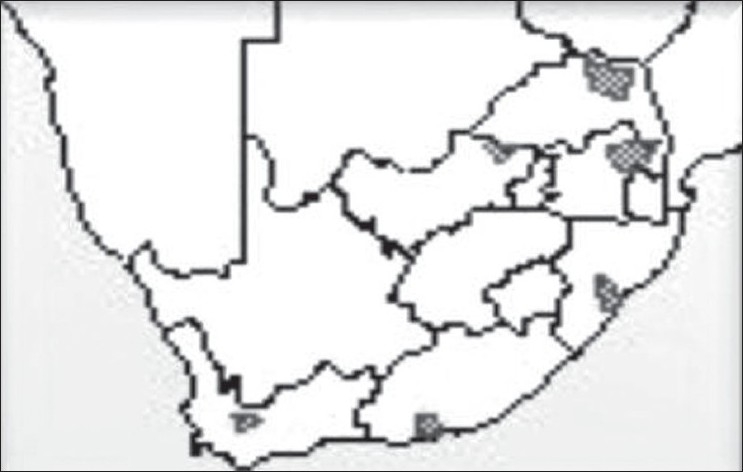
Geographical distribution of Avacodo Tree
Figure 2.
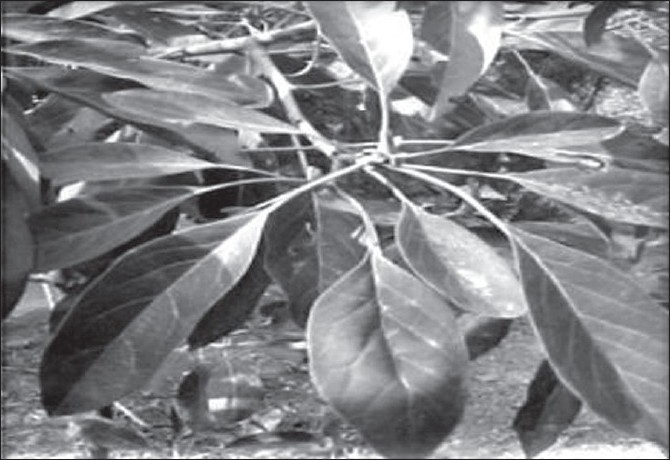
Leaves of P. americana
Figure 3.
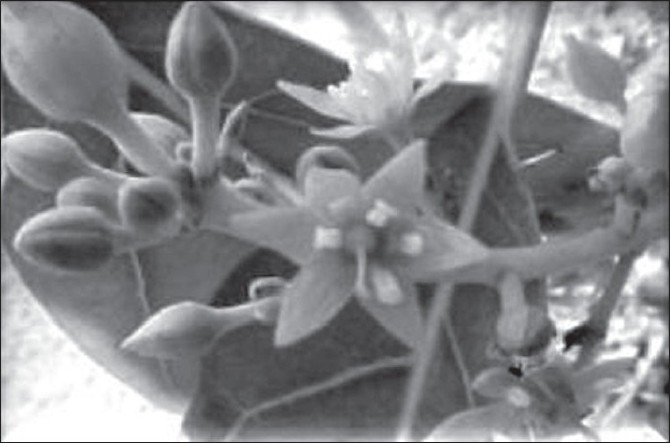
Flowers of P. americana
Figure 4.
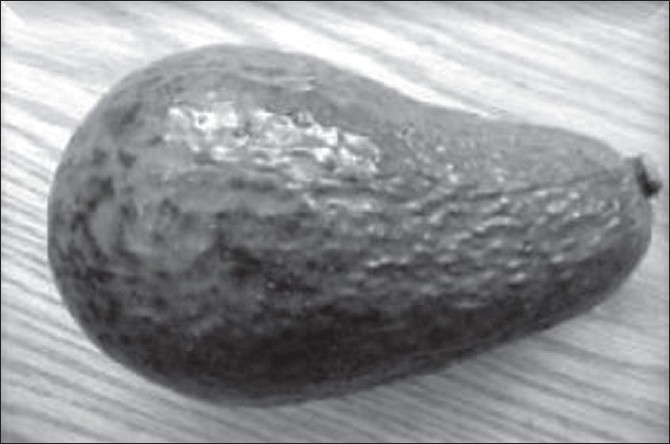
Fruits of P. americana
PHYTOCHEMISTRY
Examples of the major chemical constituents[6] of the various plant parts of avocado (P. americana Mill.) reported to date are summarized. These compound classes may be divided into alkanols (also sometimes termed “aliphatic acetogenins”) (1-17), terpenoid glycosides (18, 19), various furan ring-containing derivatives (20-30), flavonoids (31-41), and a coumarin (42). The highly functionalized alkanols (1-17)[7–10] of avocado have exhibited quite diverse biological properties thus far. For example, Oberlies et al isolated 1,2,4-trihydroxyheptadec-16-ene (1), 1,2,4-trihydroxyheptadec-16-yne (4), and 1,2,4-trihydroxynonadecane (8) from the unripe fruits of P. americana, and found these substances to be moderately cytotoxic when evaluated against a small panel of cancer cell lines.[8] Kawagishi et al isolated 5 alkanols from avocado fruits with “liver suppressing activity” (as determined by the changes in plasma levels of alanine aminotransferase and aspartate aminotransferase), including compounds 9-11.[10] An ethanol-soluble extract of the dried leaves of avocado showed antiinflammatory activity in a carrageenan-induced edema protocol, with 1,2,4-trihydroxyheptadec-16-ene (1) being obtained from the active fraction.[11] In addition, 1,2,4-trihydroxyheptadec-16-ene (1) and related compounds 2-8, purified from the seeds of P. americana, showed moderate activity against epimastigotes and trypomastigotes.[12] Persin [15; (2R,12Z,15Z)-2-hydroxy-4-oxoheneicosa-12,15-dienyl acetate], a constituent of avocado leaves, is regarded as a toxin for lactating livestock.[13] In addition, persin has been found to reduce the larval growth of the beet armyworm, Spodoptera exigua,[9] and is a known antifungal agent against Colletotrichum gloeosporioides.[14] Two analogs, persenones A (14) and B (17), along with persin (15), were found to inhibit superoxide (O2-) and nitric oxide (NO) generation in cell culture, and may thus serve as cancer chemopreventive agents in inflammation-related organs.[14] Persin (15) and 3 other analogs, compounds 3, 5, and 14, showed inhibition of acetyl CoA carboxylase activity, in the IC50 value range 4.0-9.4 M.[15] Persin (15) has been noted to be labile under acid conditions, where it produces a furan ring-containing analog.[9] The leaves of 17 avocado cultivars were investigated for their content of persin (15), and all but 2 of these contained discernible amounts of this compound (range 0.4-4.5 mg/g)[16] [Figure 1]. The glycosylated abscisic acid derivatives (1S,6R)-8-hydroxy abscisic acid-d-glucoside (18) and (1R,3R,5R,8S)-pi-dihydrophaseic acid-d-glucoside (19) were isolated from the seeds of P. americana, although no biological activities were attributed to these compounds.[17] Compounds 20-30 are furanoid constituents of avocados, [Figure 2] and have been isolated and structurally characterized or chemically synthesized by several different groups.[7,18–21] These compounds have been termed “avocadofurans” and [Figure 3] subjected to literature review, primarily from the point of view of the effects of structural modification on their resultant antibacterial, antifungal, and insecticidal activities.[22] Several flavonoids (31-41) have also been isolated from the leaves and seeds of avocados, with most of these being common flavones of wide distribution in the plant kingdom[23–26] [Figure 4]. Some of these are biologically active, such as quercetin (36), which showed virustatic effects by inhibiting HIV syncytium formation and viral p24 antigen formation.[24] An extract of avocado leaves inhibited herpes simplex virus type 1 (HSV-1) and Aujeszky's disease virus (ADV), and adenovirus type 3 (AD3). Bioactivity-guided fractionation led to the isolation of afzelin (38) and quercetin 3-O-D-arabinopyranoside (39), as inhibitors of acyclovir-resistant HSV-1.[20] The methanolic extract of avocado seeds showed antioxidant activity in an 2,2’-azobis(2,4-dimethylvaleronitrile) (AMVN)-induced methyl linoleate peroxidation assay, and catechin (40) and epicatechin (41) were isolated as major active components.[26] Also obtained as a constituent of avocado leaves is the commonly occurring plant coumarin, scopoletin (42).[23] There have been several reports of biological activity showed by the extracts prepared from plant parts of avocados (P. americana) for which the active principles have not been characterized structurally, including anticonvulsant (in mice using standard convulsant drugs to cause seizures),[27] antioxidant (inhibition of NADPH oxidase activity in HL-60 cells and of epithelial xanthine oxidase in AS52 cells),[28] “chondroprotective” (ie, reducing degenerative changes in granulomatous tissue),[29] rat skin lysyl oxidase inhibitory,[30] and periodontal disease related [including inhibition of the matrix metalloproteinase (TIMP-1 and TIMP-2) secretion in human fibroblasts[31] activities.
PHARMACOLOGICAL ACTIVITIES
Vasorelaxant activity
The aqueous extract of P. americana (0.01-12.8 mg/mL) produced a concentration-related vasorelaxation response in the rings of rat aorta with intact endothelium precontracted with noradrenaline (1 × 10–7 M), with an EC50 of 0.88 + 0.03 mg/mL. In the endothelium-denuded rings, the vasorelaxant action of the aqueous extract of P. americana was significantly attenuated (EC50.14F252.18 mg/mL). Cumulative addition of acetylcholine (1.1 × 10–8 to 1.4 × 10–5 M) produced relaxation of endothelium-intact rat aortic rings precontracted with noradrenaline (1 × 10–7 M). The vasorelaxant effect was significantly reduced by L-NAME (10–4 M) and methylene blue (10–6), but not affected by indomethacin (10–5M). The aqueous extract of P. americana (1 or 5 mg/mL) produced a rightward shift of the concentration-response curves to noradrenaline (1 × 10–9 to 1 × 10–9 M) and potassium chloride (10-80 mM). In fact, this activity was blocked by L-NAME or methylene blue, suggesting that the vasorelaxation is dependent on the synthesis and release of endothelium-derived relaxing factors (EDRFs). The blockade by indomethacin suggests that P. americana may also act by activating PGI2 and PGE2 receptors. The vasorelaxant effect may also be produced by the inhibition of Ca2+ mobilization through voltage-dependent channels and, to a lesser extent, through receptor-operated channels.[32]
Analgesic and antiinflammatory activity
The aqueous extract of P. americana leaves caused a significant and dose-dependent inhibition of the control writhes. The inhibition by 1600 mg/kg extract was similar to that produced by 100 mg/kg of acetylsalicylic acid (57.2% and 58.0%, respectively). The inhibition (87.2%) shown by 800 mg/kg of the extract was same as morphine (2 mg/kg, 87.0%). There was a significant and dose-dependent inhibition of both phases, by the extract. A greater inhibition (77.1%) was produced by the extract (800 mg/kg) compared with acetylsalicylic acid (68%) in phase II of the test. The aqueous leaf extract of P. americana (800 mg/kg) produced a significant inhibition of the swelling caused by carrageenan at 3 h. This effect was similar to that produced by indomethacin in the same duration.[33]
Hypotensive activity
The intravenous administration of doses of P. americana leaf aqueous and methanol extract ranging from 6.25 to 50 mg/kg (pilot study indicated that doses above 50 mg/kg caused death of rats within 10 min of administration; therefore, the highest screening dose for i.p. injections was 50 mg/kg) to normotensive anesthetized rats produced dose-related hypotensive effects. Doses above 12.5 mg/kg showed hypotensive effects, which were significantly different from those on the control. Also, the duration of action appeared to be dose dependent.[34]
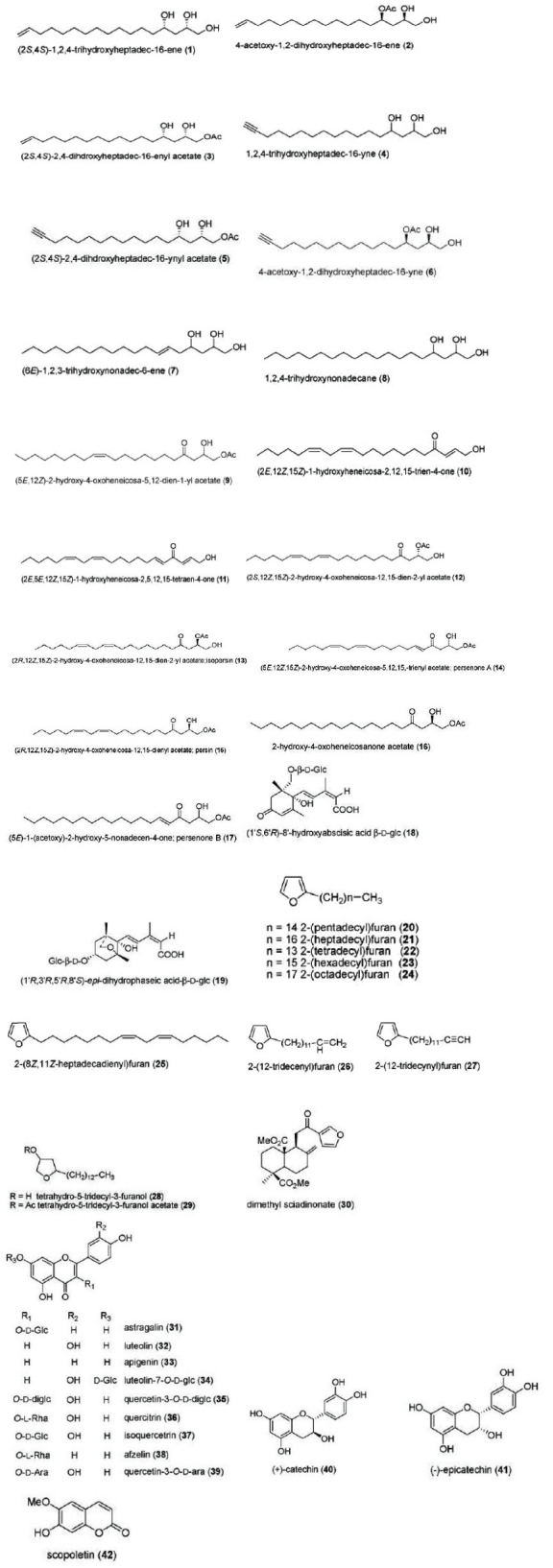
Chemical constituents of persea americana
Anticonvulsant effect
Aqueous leaf extract of P. americana possessesnticonvulsant activity in mice. The effectiveness of the plant extract in the experimental convulsion paradigm used probably suggests that the plant could be used in both petit and grand mal types of epilepsy. The plant's leaf extract was relatively more effective in Pentylenetetrazole (PTZ)- and picrotoxin (PCT)-induced convulsions than in bicuculline (BCL)-induced seizures. In general, the average onset and duration of convulsion was markedly delayed and reduced, respectively. These findings tend to suggest that P. americana leaf aqueous extract might have inhibited and/or attenuated PTZ-, PCT- and BCL-induced seizures of the mice used by enhancing, or in some ways interfering with, GABAergic action and/or neurotransmission.[35]
Antiviral activity
The infusion and ethanol extract of dried leaves of P. americana were compared with respect to their inhibitory activities of viral replication in vitro. The chosen viruses for the initial screening were adenovirus type 3 (AD3), HSV-1, and ADV. The ethanol extract was only tested against HSV-1 and ADV. The infusate was active against the 3 viruses, whereas the ethanol extract did not show any activity under the experimental conditions employed.[36]
Wound healing activity
In the excision wound model, complete healing (full epithelialization) was observed on average on day 14 in the rats, which received oral or topical treatment of P. americana fruit extract (300 mg/kg/day). In contrast, the controls took approximately 17 days to heal completely. The extract-treated wounds were found to epithelialize faster than the controls. Wet and dry granulation tissue weight and the hydroxyproline content of the tissue obtained from extract-treated animals used in the dead space wound model were significantly higher compared with those of the controls.[37]
Antiulcer effect
The study was carried out to investigate the antiulcer activity of aqueous leaf extract of P. americana. Groups of albino rats were pretreated orally with aqueous leaf extract of the plant before the administration of the ulcerogenic drugs—indomethacin and ethanol. The extract produced significant and dose-dependent antiulcer activity against indomethacin- and ethanol-induced ulcers in rat.[38]
Antihepatotoxic activity
Another group of scientists demonstrated action of avocado on liver. Martins Ekor et al carried out a study on antihepatotoxic activity in rats. The methanolic extract of P. americana could be protective against toxicity and oxidative stress arising from acute paracetamol intoxication. The mechanism of this protection is probably due to an antioxidant action of catalase (CAT), superoxide dismutase (SOD), and glutathione peroxidase, which are the primary intracellular defense mechanisms to cope with increased oxidant stress. The activities of the antioxidant enzymes measured (SOD and CAT) did not change significantly in normal rats treated with the methanolic leaf extract of P. americana; the extract, however, significantly induced the activity of these enzymes during hepatic damage produced by acute paracetamol toxicity. The methanolic leaf extract of P. americana and its hepatoprotective action against acute paracetamol toxicity make it a potential agent against liver diseases and other pathologies associated with oxidative stress.
Antioxidant activity
Kim et al isolated and demonstrated the presence of compounds persenone A and B with unique antioxidant properties in avocado fruit. It is important to clearly identify the compounds with antioxidant properties in the leaf extract of this plant. The antioxidant activity exhibited by the methanolic leaf extract of P. americana and its hepatoprotective action against acute paracetamol toxicity make it a potential agent against liver diseases and other pathologies associated with oxidative stress.
Hypoglycemic activity
Aqueous leaf extract of P. Americana possesses hypoglycemic effects in the normal rats. The maximum antidiabetic activity was reached at 6 h after a single dose of the extract was administered, producing 60.02 ± 6.83% reduction in blood glucose level.[39]
Effect on body weight
It is evident from Brail et al's study that the administration of aqueous and methanolic leaf extracts of P. Americana caused a reduction in body weight compared with the hyperlipidemic controls. It could be that P. americana leaf extracts increase the catabolism of lipids accumulated in the adipose tissue, resulting in a decrease in the mean body weight.[42,43]
Avocado improvement via biotechnologic
Disease resistance
Avocado has been transformed with an antifungal defensin gene pdf1.2[40] and the pac1 ribonuclease gene (Perea and Litz, unpublished data), respectively. The defensin gene was driven by the CaMV 35S promoter in binary vector pGPTV; the construct also contained the uidA reporter gene (GUS) and the bar gene for resistance to phosphinothricin, the active ingredient of the herbicide Finale®.
Extending shelf life
Avocado embryogenic cultures have been transformed with a modified bacteriophage gene S-adenosyl-l-methionine hydrolase (SAMase). SAMase is in a binary vector, pAG4092; the pPZP200 binary vector was utilized as a backbone.
Genetic improvement
Genetic transformation is viewed as having great potential for protecting avocado from infection by avocado sunblotch viroid (ASBVd), C. gloeosporioides and P. cinnamomi, and for addressing certain horticultural problems, for example, controlling fruit ripening, particularly in the Antillean (West Indian) cultivars.[41]
CONCLUSION
Avocados are a rich source of nutrients and phytochemicals. Although some of the individual phytochemicals found in avocado have been well characterized, many new uncharacterized phytochemicals are being discovered with potential activity. Important progress has been made in recent years toward the recovery of avocado material from tissue culture. The use of biotechnology
Footnotes
Source of Support: Nil
Conflict of Interest: None declared
REFERENCES
- 1.Anon . New Delhi, India: CSIR; 1986. [accessed on 2008 Jan 16]. The useful plants of India. Publications and Information Directorate. Available from: http://www.worldagroforestry.org/sea/products/AFDbases/AF/asp/SpeciesInfo.asp?SpID=1274 . [Google Scholar]
- 2.Bekele-Tesemma A, Birnie A, Tengnas B. Useful trees and shrubs for Ethiopia.Regional Soil Conservation Unit (RSCU), Swedish International Development Authority (SIDA) 1993 [Google Scholar]
- 3.Cobley LS, Steele WM. An Introduction to the Botany of Tropical Crops. Longman Group Limited. 1976 [Google Scholar]
- 4.Crane E. Honey: A comprehensive survey. In: Crane E, editor. Bee Research Association; 1976. [Google Scholar]
- 5.Crane E, Walker P. London, UK: International Bee Research Association; 1984. Pollination directory for world crops. [Google Scholar]
- 6.Ding H, Chin YW, Kinghorn AD, D’Ambrosio SM. Chemopreventive characteristics of avocado fruit. Semi Cancer Biol. 2007;17:386–94. doi: 10.1016/j.semcancer.2007.04.003. [DOI] [PubMed] [Google Scholar]
- 7.Kashman Y, Neeman I, Lifshitz A. New compounds from avocado pear. Tetrahedron. 1969;25:4617–31. [Google Scholar]
- 8.Oberlies NH, Rogers LL, Martin JM, McLaughlin JL. Cytotoxic and insecticidal constituents of the unripe fruit of Persea americana. J Nat Prod. 1998;61:781–5. doi: 10.1021/np9800304. [DOI] [PubMed] [Google Scholar]
- 9.Rodriguez-Saona C, Millar JG, Trumble JT. Isolation, identifi cation, and biological activity of isopersin: a new compound from avocado idioblast oil cells. J Nat Prod. 1998;61:1168–70. doi: 10.1021/np980127q. [DOI] [PubMed] [Google Scholar]
- 10.Kawagishi H, Fukumoto Y, Hatakeyama M, He P, Arimoto H, Matsuzawa T, et al. Liver injury suppressing compounds from avocado (Persea americana) J Agric Food Chem. 2001;49:2215–21. doi: 10.1021/jf0015120. [DOI] [PubMed] [Google Scholar]
- 11.Guevarra AP, Espino MP, Chua C, Russel G. Anti-inflammatory principles of the leaves of Persea americana Mill. Philipp J Sci. 1998;127:81–91. [Google Scholar]
- 12.Abe F, Nagafuji S, Okawa M, Kinjo J, Akahane H, Ogura T, et al. Trypanocidal constituents in plants 5.Evaluation of some Mexican plants for their trypanocidal activity and active constituents in the seeds of Persea americana. Biol Pharm Bull. 2005;28:1314–7. doi: 10.1248/bpb.28.1314. [DOI] [PubMed] [Google Scholar]
- 13.Oelrichs PB, Ng JC, Seawright AA, Ward A, Schaffeler L, MacLeod JK. Isolation and identification of a compound from avocado (Persea americana) leaves which causes necrosis of the acinar epithelium of the lactating mammary gland and the myocardium. Nat Toxins. 1995;3:344–9. doi: 10.1002/nt.2620030504. [DOI] [PubMed] [Google Scholar]
- 14.Domergue F, Helms GL, Prusky D, Browse J. Antifungal compounds from idioblast cells isolated from avocado fruits. Phytochemistry. 2000;54:183–9. doi: 10.1016/s0031-9422(00)00055-8. [DOI] [PubMed] [Google Scholar]
- 15.Hashimura H, Ueda C, Kawabata J, Kasai T. Acetyl-CoA carboxylase inhibitors from avocado (Persea americana Mill) fruits. Biosci Biotechnol Biochem. 2001;65:1656–8. doi: 10.1271/bbb.65.1656. [DOI] [PubMed] [Google Scholar]
- 16.Carman RM, Handley PN. Antifungal diene in leaves of various avocado cultivars. Phytochemistry. 1999;50:1329–31. [Google Scholar]
- 17.del Refugio Ramos M, Jerz G, Villanueva S, Lopez-Dellamary F, Waibel R, Winterhalter P. Two glucosylated abscisic acid derivates from avocado seeds (Persea americana Mill.Lauraceae cv.Hass) Phytochemistry. 2004;65:955–62. doi: 10.1016/j.phytochem.2003.12.007. [DOI] [PubMed] [Google Scholar]
- 18.Murakoshi S, Isogai A, Chang FC, Kamikado T, Sakurai A, Tamura S. The effects of two components from avocado leaves (Persea americana Mill.) and related compounds on the growth of silkworm larvae. Bombyx mori L Nippon Oyo Dobutsu Konchu Gakkaishi. 1976;20:87–91. [Google Scholar]
- 19.Rodriguez-Saona CR, Maynard DF, Phillips S, Trumble JT. Alkylfurans: Effects of alkyl side-chain length on insecticidal activity. J Nat Prod. 1999;62:191–3. doi: 10.1021/np980340m. [DOI] [PubMed] [Google Scholar]
- 20.Rodriguez-Saona C, Millar JG, Maynard DF, Trumble JT. Novel antifeedant and insecticidal compounds from avocado idioblast cell oil. J Chem Ecol. 1998;24:867–89. [Google Scholar]
- 21.Rodriguez-Saona C, Maynard DF, Phillips S, Trumble JT. Avocadofurans and their tetrahydrofuran analogues: Comparison of growth inhibitory and insecticidal activity. J Agric Food Chem. 2000;48:3642–5. doi: 10.1021/jf9910638. [DOI] [PubMed] [Google Scholar]
- 22.Rodriguez-Saona C, Trumble JT. Biologically active aliphatic acetogenins from specialized idioblast oil cells. Curr Org Chem. 2000;4:1249–60. [Google Scholar]
- 23.Merici F, Merici AH, Yilmaz F, Yunculer G, Yunculer O. Flavonoids of avocado (Persea americana) leaves. Acta Pharm Turc. 1992;34:61–3. [Google Scholar]
- 24.Wigg MD, Al-Jabri AA, Costa SS, Race E, Bodo B, Oxford JS. In vitro virucidal and virustatic anti HIV-1 effects of extracts from Persea americana Mill.(avocado) leaves. Antivir Chem Chemother. 1996;7:179–83. [Google Scholar]
- 25.De Almeida AP, Miranda MM, Simoni IC, Wigg MD, Lagrota MH, Costa SS. Flavonol monoglycosides isolated from the antiviral fractions of Persea americana (Lauraceae) leaf infusion. Phytother Res. 1998;12:562–7. [Google Scholar]
- 26.Matsusaka Y, Kawabata J, Kasai T. Antioxidant constituents in avocado (Persea americana Mill.) seeds. Nippon Shoukuhin Kaegaku Kogaku Kaishi. 2003;50:550–2. [Google Scholar]
- 27.Ojewole JA, Amabeoku GJ. Anticonvulsant effect of Persea americana Mill (Lauraceae) (Avocado) leaf aqueous extract in mice. Phytother Res. 2006;20:696–700. doi: 10.1002/ptr.1940. [DOI] [PubMed] [Google Scholar]
- 28.Kim HW, Murakami A, Nakamura Y, Ohigashi H. Screening of edible Japanese plants for suppressive effects on phorbol ester-induced superoxide generation in differentiated HL-60 cells and AS52 cells. Cancer Lett. 2002;176:7–16. doi: 10.1016/s0304-3835(01)00735-2. [DOI] [PubMed] [Google Scholar]
- 29.Khayyal MT, el-Ghazaly MA. The possible “chondroprotective” effect of the unsaponifiable constituents of avocado and soya in vivo. Drugs Exp Clin Res. 1998;24:41–50. [PubMed] [Google Scholar]
- 30.Werman MJ, Neeman MS. Partial isolation and characterization of a new natural inhibitor of lysyl oxidase from avocado seed oil. J Agric Food Chem. 1990;38:2164–6. [Google Scholar]
- 31.Kut-Lasserre C, Miller CC, Ejeil AL, Gogly B, Dridi M, Piccardi N, et al. Effect of avocado and soybean unsaponifiables on gelatinase A (MMP-2), stromelysin 1 (MMP-3), and tissue inhibitors of matrix metalloproteinase (TIMP-1 and TIMP-2) secretion by human fibroblasts in culture. J Periodontol. 2001;72:1685–94. doi: 10.1902/jop.2001.72.12.1685. [DOI] [PubMed] [Google Scholar]
- 32.Owolabi MA, Jaja SI, Coker HA. Vasorelaxant action of aqueous extract of the leaves of Persea americana on isolated thoracic rat aorta. Fitoterapia. 2005;76:567–73. doi: 10.1016/j.fitote.2005.04.020. [DOI] [PubMed] [Google Scholar]
- 33.Adeyemi OO, Okpo SO, Ogunti OO. Analgesic and anti-inflammatory effects of the aqueous extract of leaves of Persea americana Mill (Lauraceae) Fitoterapia. 2002;73:375–80. doi: 10.1016/s0367-326x(02)00118-1. [DOI] [PubMed] [Google Scholar]
- 34.Adeboye JO, Fajonyomi MO, Makinde JM, Taiwo OB. A preliminary study on the hypotensive activity of Persea americana leaf extracts in anaesthetized normotensive rats. Fitoterapia. 1999;70:15–20. [Google Scholar]
- 35.Ojewole JA, Amabeoku GJ. Anticonvulsant effect of Persea americana Mill (Lauraceae) (Avocado) leaf aqueous extractin mice. Phytother Res. 2006;20:696–700. doi: 10.1002/ptr.1940. [DOI] [PubMed] [Google Scholar]
- 36.de Almeida AP, Miranda MM, Simoni IC, Wigg MD, Lagrota MH, Costa SS. Flavonol monoglycosides isolated from the antiviral fractions of Persea americana (Lauraceae) leaf infusion. Phytother Res. 1998;12:562–7. [Google Scholar]
- 37.Nayak BS, Raju SS, Rao CV. Wound healing activity of Persea americana (avocado) fruit: A preclinical study on rats. J Wound Care. 2008;17:123–5. doi: 10.12968/jowc.2008.17.3.28670. [DOI] [PubMed] [Google Scholar]
- 38.Ukwe CV, Nwafor SV. Anti-ulcer activity of aqueous leaf extract of Persea americana (family-Lauraceae) Nig J Pharm Res. 2004;3:91–5. [Google Scholar]
- 39.Anita BS, Okokon JE, Okon PA. Hypoglycemic activity of aqueous Persea americana Mill. Indan J Pharmacol. 2005;37:325–6. [Google Scholar]
- 40.Raharjo S, Witjaksono, Gomez Lim MA, Padilla G, Litz RE. Recovery of avocado (Persea americana Mill.) plants transformed with the antifungal plant defensin gene pdf1.2. In Vitro Cell Dev Biol. 2008;44:254–262. [Google Scholar]
- 41.Litz RE, Witjaksono, Raharjo S, Efendi D, Pliego-Alfaro F, Barceló-Muñoz A. Persea americana Avocado. In: Litz RE, editor. Biotechnology of Fruit and Nut Crops. Wallingford, UK: CAB International; 2005. pp. 326–47. [Google Scholar]
- 42.Pliego Alfaro F, Litz Richard E. California Avocado Society Yearbook. 2007;90:149–67. [Google Scholar]
- 43.Brai BI, Odetola AA, Agomo PU. Effects of Persea americana leaf extracts on body weight and liver lipids in rats fed hyperlipidaemic diet. Afr J Biotech. 2007;6:1007–11. [Google Scholar]


